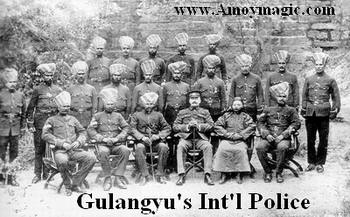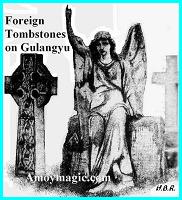I have a copy of the delightful “Fukien Arts and Industries," put out by the Anti-Cobweb Society in Fuzhou (Foochow) in 1933. The book included essays on Fujian's tea, silk, paper, lacquer, oil, lumber and bamboo industries, Chinese porcelain, etc. And I just learned a little more about the Anti-Cobweb Society from "A Race of Green Ginger", written by Mrs. Mackenzie-Grieves, who lived on Gulangyu in the 1920s:
Before we met its members, we agreed that the Anti-Cobweb Society sounded awful. 'It's to clear away the cobwebs in our minds', an Anti-Cobweb explained, and we shuddered. But we were wrong. A handful of unusual Americans and English, they believed that to know, or to try to know China in all her aspects, was an essential prerequisite of any form of good relations with the Chinese. They felt that it was more important to learn before they taught, to know before they condemned or offered alternatives. Their lot cast in Fukien, with its strange pockets of old paganism-Fukien, nearly always the last of the provinces to be subdued and recolonized by a new dynasty, the province about which the Chinese themselves hardly bothered to know the Anti-Cobwebs set themselves to learn about it.
The people of the deep Fukien valleys were not uncivilized in the same sense that the nomad tribes of China's northwestern territories were warlike and nomadic, with a history linked to Genghis Khan and the hordes who could scour Persia, and who range over tracts of Chinese history as great as their own Gobi desert; their dealings with the unknown were not through shamans and an explicit occultism. Their villages, behind the mountain barriers, still held their own dark, ancient magic, paid placating service to the haunting spirits in rites whose symbolism was long forgotten. Who had told the Hakkas to ransom their houses with blood, like the Jews in Egypt? Was it one of the wandering Jews who found the way to China? Was it one of the Nestorians, whose fellows found such favour with the Great Khan that he appointed one as Commissioner for Christian Affairs, and despatched another to Paris to visit Philip the Fair? They do not know. But neither they nor the scholars know whence they and their dog-headed prince came. Some say they are of aboriginal stock, others, that they are descendants of Chinese soldiers and aboriginal women ofa tribe called Ikia, yet a third theory is that they were pioneer emigrants from the north. Who was the Snake King of Chonghupan who, in some lost age, saved the region from drought and has been honoured ever since? Who were the Constables of Hell, whose memory the people of Fu-ch'ing [Fuqing, in Putian] celebrate by a procession of blood dripping devotees? It is all a long way from the rationally ordered, severely disciplined Confucian rites.
All these things and a great many more the Anti-Cobwebs pondered and discussed. In spring and autumn, they traveled as much as possible-most of them were missionaries-in the winter evenings they met to exchange the fruits of their researches, gathered mainly by patient observation, listening and questioning.
They were admirably frank. 'We try to get at the truth-the true facts,' one told us. 'Of course, we aren't impartial. We're biased by our religion and our Western culture, but we try not to be.' 'I suppose,' said another, 'we unconsciously distribute our mental and moral emphasis according to the standards we were brought up by.'
We talked about the old and the new learning.
The Fukienese, like all Chinese, revered learning and thirsted for knowledge, if not for themselves, then for their children. 'You can still find scholars' signboards on plenty of houses,' one of the American Anti-Cobwebs told us. 'Third degree, in crossroad hamlets, and Han-lin even in country villages.'
There was in the city, he said, still a school for advanced classical studies, taught by ten elderly Han-lin graduates, and in spite of the troubles, the ferment of revolutionary ideas and of educational reform, it was well attended. As he talked, I saw the ten old scholars, like the Eight Immortals in the carvers' shops, assured in their Confucian calm, expounding probably to the last generation of reverent ears the ethic which had been the life-study of their counterparts for over one thousand five hundred years. They must have belonged to the age when examination candidates were immured incommunicado for days, while they laboured at their Eight-legged essays on a classic Confucian theme. Had anyone of them revolted in his heart against his soul's destruction, against counting into rigid uniformity his words, sentences and paragraphs? Did any of them long to contradict the exacting shade of Chu Hsi [Zhu Xi; lived in Wuyi Mtn. for a time]? Or did they, and the thousands like them bred by centuries of conformity, submit to desiccation, like the smoke-seasoning of the wooden Immortals?
It was not until 1912 that the hundreds of hive-like State examination cells in Foochow were demolished. But the mentality bred by the Eight-legged Essay has died hard, and Mao Tze-tung still needs to-and does-warn his people against it. For five hundred years the historical and philosophical works
and the Confucian commentaries of the Fukienese scholar had been the standard texts for the civil service examinations all over China. He was as famous as Mencius, second only to the great Kung himself. In Fukien he was ever-present: below his image in the temples, incense smouldered, and, far from the towns, handfuls of field-flowers withered at his dusty feet.
Mackenzie-Grieves, 1959, "A Race of Green Ginger," pp. 129-131
Anti-Cobweb Society, “Fukien Arts and Industries: Papers by Members of the Anti-Cobweb Society, Foochow, Fukien, China,” Christian Herald Industrial Press, Foochow 1933.
Links:
www.amoymagic.com












